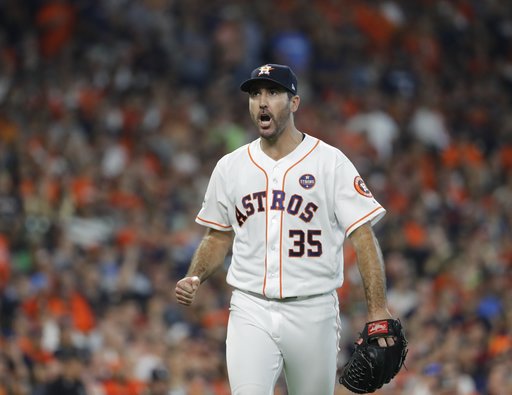Astros pitcher and American League All-Star Justin Verlander is convinced that baseball’s ongoing surge of home runs is not only the result of a more aerodynamic baseball, but is the result of a baseball that has been intentionally juiced during manufacturing in order to produce more offense. Verlander told ESPN on Mondaythat the ball is “a fucking joke” and “it’s not coincidence” that the ball is flying farther now that its manufacturer is owned by Major League Baseball.
 Manfred said in June that Rawlings hadn’t changed their manufacturing process “in any meaningful way,” but as Wills demonstrates, changes that make the ball more aerodynamic might not register as “meaningful” to a lay person—things like seams that are lower by a couple millimeters, or leather that is just slightly smoother. Stack several meaningless-seeming changes like that up, and you’ve got a ball that behaves differently in the air, and not just off the bat.Major League Baseball does in fact own Rawlings, but they purchased Rawlings last summer, after MLB was already more than two years into its ongoing spike of dinger totals. This takes some of the wind out of the idea that “all of a sudden” the balls were juiced after MLB took control over their manufacturing. On the other hand, maybe Manfred and MLB were influencing the design specs of game balls before the league bought Rawlings? If you believe the ball has been intentionally juiced, probably the fact that Manfred took over as commissioner a few months before the 2015 season, which saw league-wide dinger totals jump by 701 over the previous season, is compelling evidence of his influence. The purchase of Rawlings isn’t necessary to prop up the theory that Manfred and MLB wanted and got a ball that flies easier.Understanding that the ball is different, and then answering the question of whether baseball wants it that way, will be important for the purpose of placing the feats of modern players in proper historical context, which is a bigger part of baseball than it is of other North American professional sports. No one much frets over the changes that make football today a completely different sport from the game that was played 60 years ago, or the way changes to the rules and the court have inflated or deflated the statistical outputs of modern NBA players compared to those of earlier eras. This is a thornier issue for MLB, which has long taken the stance that advancements that make the game more interesting for fans are invalidating perversions. Verlander, for example, believes that a ball that flies farther turns baseball “into a joke,” and he is certainly not alone.The juiced ball can’t totally account for all the dingers—players are focused on launch angle like never before, slap directional hitting is so discouraged that teams routinely over-shift their defenses with only occasional negative consequences, and the Baltimore Orioles are a pile of trash. But the new, more aerodynamic ball is undoubtedly part of the equation. As that equation is better understood, presumably it will become easier to make whatever changes would be necessary for the purpose of returning baseball to an earlier iteration of itself. The question will then become not how the ball got juiced, but whether baseball as it is played in 2019 reflects the preferences of those in charge. The ball might’ve been accidentally juiced, but it can sure stay that way on purpose.Chris Thompson/Deadspin.com
Manfred said in June that Rawlings hadn’t changed their manufacturing process “in any meaningful way,” but as Wills demonstrates, changes that make the ball more aerodynamic might not register as “meaningful” to a lay person—things like seams that are lower by a couple millimeters, or leather that is just slightly smoother. Stack several meaningless-seeming changes like that up, and you’ve got a ball that behaves differently in the air, and not just off the bat.Major League Baseball does in fact own Rawlings, but they purchased Rawlings last summer, after MLB was already more than two years into its ongoing spike of dinger totals. This takes some of the wind out of the idea that “all of a sudden” the balls were juiced after MLB took control over their manufacturing. On the other hand, maybe Manfred and MLB were influencing the design specs of game balls before the league bought Rawlings? If you believe the ball has been intentionally juiced, probably the fact that Manfred took over as commissioner a few months before the 2015 season, which saw league-wide dinger totals jump by 701 over the previous season, is compelling evidence of his influence. The purchase of Rawlings isn’t necessary to prop up the theory that Manfred and MLB wanted and got a ball that flies easier.Understanding that the ball is different, and then answering the question of whether baseball wants it that way, will be important for the purpose of placing the feats of modern players in proper historical context, which is a bigger part of baseball than it is of other North American professional sports. No one much frets over the changes that make football today a completely different sport from the game that was played 60 years ago, or the way changes to the rules and the court have inflated or deflated the statistical outputs of modern NBA players compared to those of earlier eras. This is a thornier issue for MLB, which has long taken the stance that advancements that make the game more interesting for fans are invalidating perversions. Verlander, for example, believes that a ball that flies farther turns baseball “into a joke,” and he is certainly not alone.The juiced ball can’t totally account for all the dingers—players are focused on launch angle like never before, slap directional hitting is so discouraged that teams routinely over-shift their defenses with only occasional negative consequences, and the Baltimore Orioles are a pile of trash. But the new, more aerodynamic ball is undoubtedly part of the equation. As that equation is better understood, presumably it will become easier to make whatever changes would be necessary for the purpose of returning baseball to an earlier iteration of itself. The question will then become not how the ball got juiced, but whether baseball as it is played in 2019 reflects the preferences of those in charge. The ball might’ve been accidentally juiced, but it can sure stay that way on purpose.Chris Thompson/Deadspin.com
“It’s a f—-ing joke. Major League Baseball’s turning this game into a joke. They own Rawlings, and you’ve got Manfred up here saying it might be the way they center the pill. They own the f—-ing company. If any other $40 billion company bought out a $400 million company and the product changed dramatically, it’s not a guess as to what happened. We all know what happened. Manfred the first time he came in, what’d he say? He said we want more offense. All of a sudden he comes in, the balls are juiced? It’s not coincidence. We’re not idiots.” Asked if he believed the balls were intentionally juiced by the league, Verlander said: “Yes. 100 percent. They’ve been using juiced balls in the Home Run Derby forever. They know how to do it. It’s not coincidence. I find it really hard to believe that Major League Baseball owns Rawlings and just coincidentally the balls become juiced.”
Without assigning any intent, Verlander isn’t wrong about the ball itself. Part of baseball’s power surge comes down to a more aerodynamic ball. This requires no conspiracy. Several physical changes to the ball have been observed and measured—you should read this very cool examination of the ball by Dr. Meredith Wills for The Athletic—and the spike in home run totals is pronounced enough that Manfred himself was forced to concede that the new ball probably produces less drag in flight.
 Manfred said in June that Rawlings hadn’t changed their manufacturing process “in any meaningful way,” but as Wills demonstrates, changes that make the ball more aerodynamic might not register as “meaningful” to a lay person—things like seams that are lower by a couple millimeters, or leather that is just slightly smoother. Stack several meaningless-seeming changes like that up, and you’ve got a ball that behaves differently in the air, and not just off the bat.Major League Baseball does in fact own Rawlings, but they purchased Rawlings last summer, after MLB was already more than two years into its ongoing spike of dinger totals. This takes some of the wind out of the idea that “all of a sudden” the balls were juiced after MLB took control over their manufacturing. On the other hand, maybe Manfred and MLB were influencing the design specs of game balls before the league bought Rawlings? If you believe the ball has been intentionally juiced, probably the fact that Manfred took over as commissioner a few months before the 2015 season, which saw league-wide dinger totals jump by 701 over the previous season, is compelling evidence of his influence. The purchase of Rawlings isn’t necessary to prop up the theory that Manfred and MLB wanted and got a ball that flies easier.Understanding that the ball is different, and then answering the question of whether baseball wants it that way, will be important for the purpose of placing the feats of modern players in proper historical context, which is a bigger part of baseball than it is of other North American professional sports. No one much frets over the changes that make football today a completely different sport from the game that was played 60 years ago, or the way changes to the rules and the court have inflated or deflated the statistical outputs of modern NBA players compared to those of earlier eras. This is a thornier issue for MLB, which has long taken the stance that advancements that make the game more interesting for fans are invalidating perversions. Verlander, for example, believes that a ball that flies farther turns baseball “into a joke,” and he is certainly not alone.The juiced ball can’t totally account for all the dingers—players are focused on launch angle like never before, slap directional hitting is so discouraged that teams routinely over-shift their defenses with only occasional negative consequences, and the Baltimore Orioles are a pile of trash. But the new, more aerodynamic ball is undoubtedly part of the equation. As that equation is better understood, presumably it will become easier to make whatever changes would be necessary for the purpose of returning baseball to an earlier iteration of itself. The question will then become not how the ball got juiced, but whether baseball as it is played in 2019 reflects the preferences of those in charge. The ball might’ve been accidentally juiced, but it can sure stay that way on purpose.Chris Thompson/Deadspin.com
Manfred said in June that Rawlings hadn’t changed their manufacturing process “in any meaningful way,” but as Wills demonstrates, changes that make the ball more aerodynamic might not register as “meaningful” to a lay person—things like seams that are lower by a couple millimeters, or leather that is just slightly smoother. Stack several meaningless-seeming changes like that up, and you’ve got a ball that behaves differently in the air, and not just off the bat.Major League Baseball does in fact own Rawlings, but they purchased Rawlings last summer, after MLB was already more than two years into its ongoing spike of dinger totals. This takes some of the wind out of the idea that “all of a sudden” the balls were juiced after MLB took control over their manufacturing. On the other hand, maybe Manfred and MLB were influencing the design specs of game balls before the league bought Rawlings? If you believe the ball has been intentionally juiced, probably the fact that Manfred took over as commissioner a few months before the 2015 season, which saw league-wide dinger totals jump by 701 over the previous season, is compelling evidence of his influence. The purchase of Rawlings isn’t necessary to prop up the theory that Manfred and MLB wanted and got a ball that flies easier.Understanding that the ball is different, and then answering the question of whether baseball wants it that way, will be important for the purpose of placing the feats of modern players in proper historical context, which is a bigger part of baseball than it is of other North American professional sports. No one much frets over the changes that make football today a completely different sport from the game that was played 60 years ago, or the way changes to the rules and the court have inflated or deflated the statistical outputs of modern NBA players compared to those of earlier eras. This is a thornier issue for MLB, which has long taken the stance that advancements that make the game more interesting for fans are invalidating perversions. Verlander, for example, believes that a ball that flies farther turns baseball “into a joke,” and he is certainly not alone.The juiced ball can’t totally account for all the dingers—players are focused on launch angle like never before, slap directional hitting is so discouraged that teams routinely over-shift their defenses with only occasional negative consequences, and the Baltimore Orioles are a pile of trash. But the new, more aerodynamic ball is undoubtedly part of the equation. As that equation is better understood, presumably it will become easier to make whatever changes would be necessary for the purpose of returning baseball to an earlier iteration of itself. The question will then become not how the ball got juiced, but whether baseball as it is played in 2019 reflects the preferences of those in charge. The ball might’ve been accidentally juiced, but it can sure stay that way on purpose.Chris Thompson/Deadspin.com


